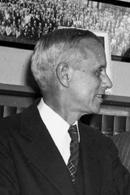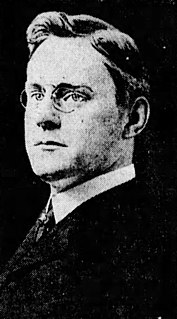
Eduard Adolf Strasburger was a Polish-German professor and one of the most famous botanists of the 19th century.

Johannes Eugenius Bülow Warming, known as Eugen Warming, was a Danish botanist and a main founding figure of the scientific discipline of ecology. Warming wrote the first textbook (1895) on plant ecology, taught the first university course in ecology and gave the concept its meaning and content. “If one individual can be singled out to be honoured as the founder of ecology, Warming should gain precedence”.

The crown is the top of the head, or the whole head.
Ordination or gradient analysis, in multivariate analysis, is a method complementary to data clustering, and used mainly in exploratory data analysis. Ordination orders objects that are characterized by values on multiple variables so that similar objects are near each other and dissimilar objects are farther from each other. Such relationships between the objects, on each of several axes, are then characterized numerically and/or graphically. Many ordination techniques exist, including principal components analysis (PCA), non-metric multidimensional scaling (NMDS), correspondence analysis (CA) and its derivatives, Bray–Curtis ordination, and redundancy analysis (RDA), among others.

William Francis Ganong, M.A., Ph.D., LL.D., F.R.S.C., was a Canadian biologist botanist, historian and cartographer. His botany career was spent mainly as a professor at Smith College in Northampton, Massachusetts. In his private life he contributed to the historical and geographical understanding of his native New Brunswick.

Edmund Ware Sinnott was an American botanist and prolific textbook author. He is best known for his work in plant morphology.

Karl Anton Eugen Prantl, also known as Carl Anton Eugen Prantl, was a German botanist.

Eliza Frances Andrews was a popular Southern writer of the Gilded Age. Her works were published in popular magazines and papers, including the New York World and Godey's Lady's Book. Her longer works included The War-Time Journal of a Georgian Girl (1908) and two botany textbooks.
Lester Whyland Sharp was an American botanist, a pioneer in cytogenetics.

Cyril Tenison ("C.T.") White was an Australian botanist.

Almira Hart Lincoln Phelps was a 19th-century American educator, author, and editor. Though she primarily wrote regarding nature, she also was a writer of novels, essays, and memoir.
Wayne P. Armstrong is a natural historian, author, photographer, and creator of the extensive online natural history textbook, Wayne's Word: An Online Textbook Of Natural History. He was a professor of botany at Palomar College, now adjunct professor. He is an expert on the flora of North San Diego County. He wrote the section on duckweeds, subfamily Lemnoideae, in the revised Jepson Manual. He specializes in macrophotography of unusual and little-known plants and animals.

Alice Crane Haskins Swingle was an American government botanist. With her husband, botanist Deane Bret Swingle (1879–1944), she co-authored the 1928 book A Textbook of Systematic Botany.

Hazel Marguerite Schmoll (1890–1990) was an American botanist, and the first to conduct a systematic study of plant life in southwestern Colorado. She was also the first woman to earn a doctorate in botany from the University of Chicago. She was elected to the Colorado Women's Hall of Fame in 1985.

Charles Stuart Gager was an American botanist who served as director of the Brooklyn Botanic Garden for over 30 years. He served as president of the Botanical Society of America and the Torrey Botanical Club. Born in Norwich, New York, he graduated from Syracuse University in 1895, and earned a PhD at Cornell in 1902. Between 1895 and 1910 he taught biology and botany at New York State Normal College, Rutgers University, New York University, and the University of Missouri, and was laboratory director at the New York Botanical Garden. He was called to direct the Brooklyn Botanical Garden in 1910, and under his directorship the Garden expanded its role in public education, especially children's education. His works include the textbooks Fundamentals of Botany (1916) and General Botany, with Special Reference to its Economic Aspects (1926). He died in Waterville, Maine.
Oswald Tippo was an American botanist and administrator at the University of Massachusetts Amherst, where he served as provost and then first chancellor. He wrote the widely used textbook College Botany with H. J. Fuller, served as president of the Botanical Society of America in 1955, and was a fellow of the American Academy of Arts and Sciences and member of the American Association for the Advancement of Science. He graduated from University of Massachusetts Amherst and Harvard University.
Adriance Sherwood Foster (1901–1973) was an American botanist known for his studies of plant anatomy. The first plant anatomist at the University of California, Berkeley, he was a two-time recipient of a Guggenheim Fellowship and served as president of the Botanical Society of America and the International Society of Plant Morphologists. His textbooks Practical Plant Anatomy and Comparative Morphology of Vascular Plants were widely adopted and influential. Foster was born in Poughkeepsie, New York, August 6, 1901, and earned a B.S. at Cornell in 1923, followed by a master's (1925) and doctorate (1926) at Harvard under Irving W. Bailey. After earning his doctorate he spent two years in England working at the University of Leeds, and from 1928 to 1934 was professor of botany at the University of Oklahoma. He joined the U.C. Berkeley faculty in 1934, retiring as professor emeritus in 1968. Foster died on May 1, 1973 from complications of spinal osteomyelitis.

Bertha Stoneman was an American-born South African botanist. She was president of Huguenot College from 1921 to 1933, and founder of the South African Association of University Women.
Beryl Brintnall Simpson is a professor emeritus in the Department of Integrative Biology at the University of Texas at Austin. Previously she was an associate curator at the Smithsonian National Museum of Natural History in the Department of Botany. She studies tropical botany, focusing on angiosperms found in the American Southwest, Mexico, and Central and South America. She was awarded the José Cuatrecasas Medal for Excellence in Tropical Botany for her decades of work on the subject.













